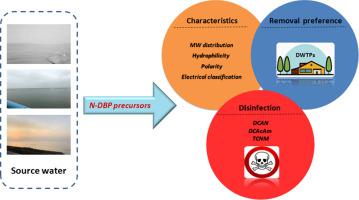Science of the Total Environment ( IF 9.8 ) Pub Date : 2020-07-03 , DOI: 10.1016/j.scitotenv.2020.140566 Shisheng Zhang 1 , Tao Lin 1 , Han Chen 1 , Hang Xu 1 , Wei Chen 1 , Hui Tao 1

|
The emergence of nitrogenous disinfection byproducts (N-DBPs) in drinking water has become a widespread concern. In this study, dichloroacetonitrile (DCAN), dicholoacetamide (DCAcAm) and trichloronitromethane (TCNM) were chosen as representatives to clarify the characteristics of N-DBP precursors in the raw waters of Taihu Lake, the Yangtze River, and Gaoyou Lake. Removal of DCAN and DCAcAm precursors must focus on nonpolar and positively charged organics, but more attention should be paid to micromolecular, polar and non-positively charged organics as TCNM precursors. Compared to molecular weight (MW) and hydrophilicity fractionation, polarity and electrical classification have higher selectivity to intercept N-DBP precursors. The properties of N-DBP precursors are relatively fixed and traceable in water systems, which could contribute to their targeted removal. Based on investigation of their characteristics, the removal efficiency and preferences of organic precursors under different processes were studied in three drinking water treatment plants (DWTPs). The TCNM precursors produced in preozonation can be effectively removed during coagulation. The cumulative removal efficiency of conventional processes on N-DBP precursors was approximately 20–30%, but O3/BAC process improved removal by about 40%. The key to improving the removal efficiency of N-DBP precursors by O3/BAC is that it can significantly remove low-MW, nonpolar, positively charged, hydrophilic and transphilic organics. In combined toxicity trials, both cytotoxicity and genotoxicity showed a synergistic effect when DCAN, DCAcAm, and TCNM coexisted, which means that low-level toxicity enhancement in the actual water merits attention. DCAN precursors dominated in the toxicity formation potential (TFP), followed by TCNM precursors. In addition, the removal rate of total N-DBP precursors may be higher than that of TFP, leading to overly optimistic evaluation of precursor removal in water treatment practice. Therefore, the removal effect on TFP must also be considered.
中文翻译:

典型的含氮消毒副产物的前体:特征,去除和潜在的毒性。
饮用水中含氮消毒副产物(N-DBP)的出现已引起广泛关注。在这项研究中,以二氯乙腈(DCAN),二氯乙酰胺(DCAcAm)和三氯硝基甲烷(TCNM)为代表,以阐明太湖,长江和高邮湖原水中N-DBP前体的特征。DCAN和DCAcAm前体的去除必须集中在非极性和带正电的有机物上,但应更多地注意作为TCNM前体的微分子,极性和非带正电的有机物。与分子量(MW)和亲水性分级相比,极性和电分类具有更高的选择性来拦截N-DBP前体。N-DBP前体的性质在水系统中相对固定且可追溯,这可能有助于对其进行有针对性的清除。基于对它们的特性的研究,在三个饮用水处理厂(DWTP)中研究了不同工艺下有机前体的去除效率和偏好。预臭氧化过程中产生的TCNM前体可以在凝结过程中有效去除。传统工艺对N-DBP前体的累积去除效率约为20–30%,但O3 / BAC工艺将去除率提高了约40%。O 3 / BAC提高N-DBP前驱物去除效率的关键在于,它可以显着去除低分子量,非极性,带正电荷的亲水性和亲和性有机物。在联合毒性试验中,当DCAN,DCAcAm和TCNM并存时,细胞毒性和基因毒性均显示出协同效应,这意味着在实际水中进行低水平的毒性增强值得关注。DCAN前体在毒性形成潜能(TFP)中占主导地位,其次是TCNM前体。此外,总N-DBP前体的去除率可能高于TFP,这导致在水处理实践中对前体去除的评估过于乐观。因此,还必须考虑对TFP的去除效果。


























 京公网安备 11010802027423号
京公网安备 11010802027423号